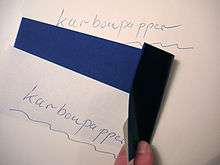Carbon copy

In the past, a carbon copy was the under-copy of a document created when carbon paper was placed between the original and the under-copy during the production of a document.[1] Nowadays "carbon copy" is often used metaphorically to refer simply to an exact copy. It is not to be confused with the carbon print family of photographic reproduction processes.
Use
A sheet of carbon paper is placed between two or more sheets of paper. The pressure applied by the writing implement (pen, pencil, typewriter or impact printer) to the top sheet causes pigment from the carbon paper to make a similar mark on the copy sheet(s). More than one copy can be made by stacking several sheets with carbon paper between each pair. Four or five copies is a practical limit. The top sheet is the original and each of the additional sheets is called a carbon copy.
The use of carbon copies declined with the advent of photocopying and electronic document creation and distribution (word processing). Carbon copies are still sometimes used in special applications: for example, in manual receipt books which have a multiple-use sheet of carbon paper supplied, so that the user can keep an exact copy of each receipt issued, although even here carbonless copy paper is often used to the same effect.
It is still common for a business letter to include, at the end, a list of names preceded by the abbreviation "CC", indicating that the named persons are to receive copies of the letter, even though carbon paper is no longer used to make the copies.
An alternative etymology is that "c:" was used for copy and "cc:" indicates the plural, just as "p." means page and "pp." means pages. This alternative etymology explains the frequent usage of "c:" when only one recipient is listed, while "cc:" is used for two or more recipients of the copies. This etymology can also explain why, even originally, "cc:" was used to list recipients who received typed copies and not necessarily carbon copies.[2]
The term "carbon copy" can be used in reference to anything that was a near duplicate of an original ("...and you want to turn him into a carbon copy of every fourth-rate conformist in this frightened land!", Heinlein, Stranger in a Strange Land).
Use as a verb
Carbon copy can be used as a transitive verb with the meaning described under e-mail below related to the CC field of an e-mail message. That is, to send the message to additional recipients beyond the primary recipient. It is common practice to abbreviate the verb form, and many forms are acceptable, including cc and cc:. Past tense forms in use are CCed, cc'd, cc'ed, cc-ed and cc:'d.[3] Present participle or imperfect forms in use include cc'ing. Merriam-Webster uses cc, cc'd and cc'ing, respectively.[4]
In e-mail, the abbreviation CC indicates those who are to receive a copy of a message addressed primarily to another (CC is the abbreviation of courtesy copy). The list of recipients in copy is visible to all other recipients of the message. An additional BCC (blind carbon copy) field is available for hidden notification; recipients listed in the BCC field receive a copy of the message, but are not shown on any other recipient's copy (including other BCC recipients). It is considered good practice to indicate to the other recipients that a new participant has been added to the list of receivers (e.g. by writing "I sent a copy to John Doe" or "John Doe, who is reading in copy, [...]").
In common usage, the To field recipients are the primary audience of the message, CC field recipients are others to whom the author wishes to send the message publicly, and BCC field recipients are the others to whom the message is sent.[5]
Printers
Dot matrix and daisy wheel printers are also able to use carbon paper to produce multiple copies of a document in one pass, and most models feature adjustable impact power and head spacing to accommodate up to three copies plus the original printout. Usually, this feature is used in conjunction with continuous, prearranged perforated paper and carbon supplies for use with a tractor feeder, rather than with single sheets of paper, for example, when printing out commercial invoices or receipts.
See also
| Look up carbon copy in Wiktionary, the free dictionary. |
References
- ↑ Beal, Peter. (2008) "carbon copy" in A Dictionary of English Manuscript Terminology 1450–2000. Online edition. Oxford University Press, 2008. http://www.oxfordreference.com Retrieved 22 November 2013.
- ↑ "CC all readers". New Scientist. 2011. Retrieved 2011-08-03.
- ↑ "What To Do When You Are Cc:’d". thestudio.com. 2012. Retrieved 2012-07-18.
- ↑ "CC". Merriam-Webster, Incorporated. 2012. Retrieved 2016-11-17.
- ↑ Resnick, Pete (April 2001). "RFC 2822 - Internet Message Format". The Internet Society. Retrieved 2008-04-11.